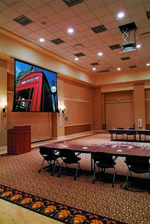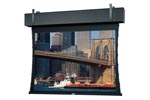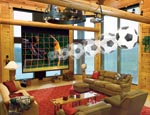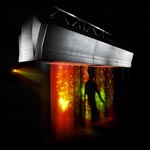Screens Don't Get Enough Respect!

Article after article has covered the topic of the best projection technology, and more recently the best flat panel displays. If we stay in the realm of projectors for this article, we know that in the "old days" lumens were very scarce and even more expensive to come by. For those who do not remember the good old days, a typical CRT projector in the mid- to late-1980s produced a whopping 130 lumens of light output on a good day. It was constant battle to get enough brightness on screen, and heaven forbid if you turned the lights on for a decent reading level.
To help in this quest for brightness, companies like Stewart Filmscreen, Da-Lite, and Draper, among others, brought forth high-gain front and rear screens to address the problem of brightness and help the projector manufacturers provide a bright enough image. In the early days, it was rare to concentrate in-depth on image quality, color space, contrast, and as my friend Don Stewart of Stewart Filmscreen preaches, dynamic range. Fast-forward to modern times, and now we have a plethora of lumens to deal with and they are pretty cheap or, as my friends remind me, inexpensive. This leaves us with a great deal of brightness and a lot more to work with as we search for the holy grail of picture quality. It is now time to concentrate on creating the "perfect" picture, and projection screens should be understood and respected as the vital links in making this happen.
As I continue to vent about screens, I will save comments on the extreme screen configurations for another article. Most systems designers' goals are to create display systems that replicate the look and feel of 35mm film and provide the total experience for the viewer that was intended by the creator of the material. Due to developments in projectors and projection screens, we now have the luxury of pursuing dynamic range on screen in terms of a given environment. We are talking about projector/screen combinations, taking into consideration "proper" contrast, color saturation and color space, uniformity, viewing angle, and yes, brightness. When we mention the word "proper," we are referring to a properly designed system employing proper professional calibration to attain a high degree of picture performance.
No longer do the projection screen companies simply have to compensate for the lack of brightness produced by projectors. They now have multiple factors to work with, and they must take into consideration a number of key elements. For example, there is the battle of the chips with DLP (single or 3-chip), LCD, and LCoS all producing their own unique images. There are lamps and lamp decay to consider, with metal halide and xenon versions available, not to mention the quality of optical engines to factor in. Last but not least, there are the processors and scalers that can impede or improve the image on screen. Before you become distressed, there is most certainly the integrity of the signals to consider, as well as the weak link in so many systems which are the cables and connectors binding it all together. All of these variables are too wide a path to take in a short article, so lets take a leap of faith and say that all things being equal it comes down to the projector, screen, and of course, the environment.
New And Improved
In terms of the newest projection screen products on the market, perhaps the three most significant advances are in the areas of gray screen technologies, high performance glass substrate rear screens, and audibly transparent perforated screens. It is certain that I will be taken to task for not mentioning the newest screen tensioning devices, seamless screen sizes, masking capabilities, and optical screen developments, but when we look at the mainstream, we must focus on these most significant developments.
First let's look at gray screen technology from companies like Stewart Filmscreen and Draper. The big deal, if you will, is the significant improvement in contrast and the maintaining of the white levels by utilizing low gain or even below unity gain gray screens in a given environment. In side-by-side comparisons with unity gain matte white screens, the results are impressive to say the least. In my tests, the angle of view is reduced over a matte white unity gain screen, but dynamically, the 60/70-degree cone in the center is a thing of beauty. With inexpensive (not cheap) lumens, we have the horsepower to drive a low gain gray screen and improve contrast and overall dynamic range significantly.
My second favorite technology advancement is the patented StarGlas from Stewart Filmscreen. This is truly a revolutionary rear screen material that consists of a proprietary diffusion layer between specially formulated glass substrates. Its claim to fame is that it is actually rated by architects and designers as a building material and qualifies as safety glass. It provides excellent performance in terms of contrast and low light back scattering, as well as superb uniformity behind the AR coating layer. It is also highly abrasion and stain resistant, making is a great choice for storefronts and any place you currently use a traditional rear screen. Finally it comes in up to 126- x 204-inch sizes and a couple of configurations, StarGlas 60 which is a black screen technology, and StarGlas 100 which is excellent for edge blending. Its most recent application is IAC in New York City, and it must be seen to be believed.
My final pick involves the new perforated screens with transparent audio capabilities that are becoming so popular in residential applications, and in some commercial venues as well. The issue here is that these new designs basically eliminate the old moiré patterns on the front surfaces, especially noticeable when using digital fixed matrix projectors, and they provide nearly transparent audio in the process. Of course this is a design issue and emulates what is seen in high-end theaters with surround sound systems.
The message to me is clear. In today's display environment it is critical to understand how important the projection screen is to the system you are designing and installing. All of the environmental elements must be considered and the key elements of screen technologies must be engineered in at the beginning. After this is completed, a professional display calibration by a qualified technician must be performed, and the resulting images that you produce will be a pleasure for all to see.
A daily selection of the top stories for AV integrators, resellers and consultants. Sign up below.
Out Of Sight
- Screens that are recessed above the ceiling can provide additional cost savings and security. Recessed screens allow the room to serves many different functions, and when not in use the screen is out of view. Draper's Signature/Series V--shown here along with a Draper ScissorLift in AVI Systems' installation at the PIPAC Centre on the Lake in Cedar Falls, IA--features a motorized trap door that opens inside the case to let the screen down, then closes and completely hides the screen above the ceiling when not in use. When equipped with a quiet motor, reduced motor noise is another plus.
- -Photo credit Rod VanderWerf
Screen Selection
The selection and integration of the screen is very complex, and there is general agreement from all the major screen manufacturers that the following screen elements need to be taken into consideration:
• Gain is a relative measure of a screen's reflectivity and will vary by screen type.
• Contrast is the ability to accurately reproduce and differentiate light and dark colors and when maximized, improves the appearance of depth of field on screen.
• Ambient light rejection properties are the ability to perform well under normal to adverse audience lighting conditions.
• Resolution is the clarity and detail of the projected image.
• Uniformity is the screen's performance when viewed from various points off axis horizontally and vertically, and when the brightness of the center of the image is compared to the brightness in the corners.
Help Is On The Way
The complexity of selecting the proper projector/screen combinations is considerable. The designer must take into consideration a range of environmental challenges, including ambient light from windows, doors, and reflective surfaces, proper screen size to the audience positioning, projector location, projection screen type (front or rear), portable or permanent installation, sources and signals, etc. The good news is that you have a lot to work with in terms of support and new screen products from the screen manufacturers. Many leading companies offer application engineering support to help dealers select the proper screen for a given environment. I do not mean to imply that a dealer's responsibility can be assumed by the screen manufacturer, but that they are truly there to help out. There is no substitute for a properly trained dealer understanding the variables with which they are faced.

dnp Supernova Epic Screen
dnp denmark released a new product in the Supernova family. The new Supernova Epic Screen provides widescreen reproduction of movies in all aspect ratios displaying superior high-contrast images in 100 percent neutral color. Maintaining a constant image height as in a movie theater, the Supernova Epic's motorized masking system is fully adjustable from closed to 2.40:1 settings delivering the ultimate viewing experience for even the most demanding videophile. It offers the flexibility of beautifully displaying all formats from 4:3 to ultra-wide 2.40:1 Cinemascope with enhanced resolution, contrast and 100 percent color accuracy.

Vutec Vu-Easy
Vu-Easy is a high quality fixed-wall projection screen. It's a permanently-tensioned wall screen that is available in a choice of seven screen surfaces to suit your viewing environment. Vu-Easy's standard features include a black velvet beveled frame, the VTS system for easy installation and is available in 4:3, 16:9 and 2.35:1 formats to compliment any size viewing room. Vu-Easy is also available in Vutec's acoustically transparent SoundScreen, that allows speaker placement behind the screen for an optimal sound experience.

Da-Lite 16 Foot Seamless Fabrics
16 foot wide Seamless Flexible Fabrics are now available for eight Da-Lite screen materials. Da-Mat, High Contrast Da-Mat, Pearlescent, Cinema Vision, High Contrast Cinema Vision, Da-Tex, High Contrast Da-Tex and Dual Vision surfaces are now available in sixteen-foot widths to meet the needs of large venue applications. Sixteen-foot wide seamless surfaces can be used on Fixed Frame screens, Fast-Fold Portable screens, Large Tensioned Cosmopolitan screens, Tensioned Professional screens and Lace and Grommet screen surfaces.
Stewart Filmscreen Pneumatic Bubble Screen
Stewart Filmscreen Corporation introduced its Pneumatic Bubble Screen. The half-sphere screen offers a unique display for various commercial screen applications. The Pneumatic Bubble Screen is a half-dome screen that can be used for digital signage, museums, art installations, point-of-purchase displays, and more. The half-sphere screen allows 360 degrees of viewing around the screen. Made using Stewart's Filmscreen 100 rear-projection screen material, the screen has a dark tint for added contrast, is excellent in rooms where ambient light is a concern, eliminates hot spotting, and has good viewing angles.

Elite Screens CineTension2
The CineTension2 screen has been equipped with all new features. Although the CineTension 2 utilizes the same design as its predecessor, it distinguishes itself by including additional features to really maximize the benefit. The screen material comes in matte white, high gain white or high contrast gray tension material with sizes ranging from 84 to 150 inches. Your choice of commercial 4:3 and residential 16:9 aspect ratios are in stock now and available for immediate distribution. The CineTension2 series still comes with its desired plug and play assembly, sliding wall/ceiling brackets, wall control unit, and IR/RF remote controls included.

Draper Expanded Controls & Motor Options
Draper has announced the addition of new controls and motor options for motorized projection screens. In addition to Z Wave compatibility, external network communication via RS232, dry contact, infrared remote control and other input devices to control the screen, Draper now offers screens with many of these capabilities built into the motor. The new motors with built-in low voltage controllers allow remote control capabilities without the need to add on external pieces-and without adding to the length of the screen case.
AVStumpfl Monoblox
The Monoblox mobile projection screen system, with its enhanced design, sets a standard for performance, durability and rock solid stability for folding projection screens. Monoblox features an innovative push button locking hinge to make rigid assembly a snap. Complete screen kits are available in standard sizes and aspect ratios including HDTV for both front and rear projection in either System 32 or heavier duty System 64. Complete drapery trim kits are available. In addition, Monoblox offers the OS system that can be interchangted with most other brands of mobile projection screens.

FogScreen One Projection Screen
FogScreen's One projection screen now allows a deeper breadth of creativity wherever there is a desire to attract a crowd and visually capture interest. The one-meter-wide screen is seamlessly linkable with additional FogScreen One projection units. The result is a screen of dry fog that is customizable to any size for any venue--with no gaps between the adjoining screens. There is no limit to how many One units can be linked together. The larger setups are ideal for live stage events and where larger effects are desired. The smaller setup is ideal for more intimate settings.
Da-Lite...www.da-lite.com
Draper...www.draper.com
Stewart Filmscreen...www.stewartfilmscreen.com
